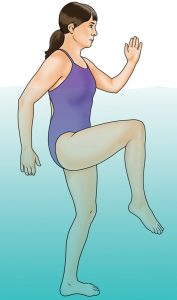Hydrotherapy: More Than Water Aerobics
What is hydrotherapy and what benefits can you expect when starting a program?
Hydrotherapy, also known as aquatic therapy, is a skilled intervention provided by a physical or occupational therapist in an inpatient or outpatient clinical setting. Don’t confuse it, however, with aquatic aerobics, or water aerobics.
Hydrotherapy uses the properties that water offers—including buoyancy, temperature, and pressure—to provide therapeutic pain relief for individuals suffering from musculoskeletal injuries, arthritis, cardiovascular disease, neuromuscular disorders, or burns.
Hydrotherapy can also be used to increase muscle strength, cardiovascular endurance, range of motion, and balance, and to normalize gait.

Here’s an example of a water exercise that may be used in some hydrotherapy: water marching, in which you’d make continuous strides, as if marching in place, for around two minutes.
How Does Hydrotherapy Treat Musculoskeletal Injuries and Joint Pain?
Hydrotherapy is commonly used to treat:
- Athletes with musculoskeletal injuries
- Aging individuals with arthritis
- Overweight individuals who have difficulty with movement due to pain and loss of mobility
For these ailing individuals, “land training” or therapy can be quite painful. In hydrotherapy, water’s property of buoyancy is used to “un-weight” the body and reduce the effects of gravity.
By decreasing the amount of weight the body must move and the compressive forces of gravity, therapy in a pool is easier on the joints. It also helps promote mobility, strength, and cardiovascular training and decreases pain.
How Does Hydrotherapy Treat Neuromuscular Disorders?
Hydrotherapy also can be beneficial for individuals suffering from multiple sclerosis, cerebral palsy, spinal cord injury, traumatic brain injury, and stroke. Water buoyancy and temperature aid in muscle relaxation, decreased muscle spasm, and decreased pain associated with these disorders.
By completing therapy in a temperature-controlled pool, some individuals are able to better control muscle spasm and pain and increase their range of motion. This treatment allows them to get more benefits out of therapy than they would in a land-based program.
For example, individuals with multiple sclerosis may suffer from dysesthesia, which involves painful burning, electrical shock-like sensations, and a general tightening of muscles in the whole body. Therapy in a lukewarm pool can help ease the painful effects of dysesthesia along with other pain modalities.
Individuals with neuromuscular disorders also can benefit from buoyancy and water resistance because these properties slow down movements while in a pool. As such, individuals can be coached on dynamic balance and abnormalities during walking.
Many stroke sufferers will experience weakness in the arm and leg on one side of the body, making it difficult to walk, which leads to increased falls at home. By completing hydrotherapy in a pool, these individuals are often able to lift their limbs and work muscles that they otherwise wouldn’t be able to on land. Because water slows down their movements, they’re also able to work on walking form with a therapist without falling and injuring themselves on a hard surface.
HOW DOES HYDROTHERAPHY ASSIST IN HEALING BURN VICTIMS?
One of the less common uses of hydrotherapy is to aid in the healing of burn victims. Individuals that suffer in tragic burn accidents or explosions often experience extremely deep burns that must be debrided in order to heal.
Debridement is the process of removing dead tissue and cleansing the burns or wounds in order to prevent infection and promote new tissue growth. However, this process has been somewhat replaced with different methods that are less labor-intensive and more sanitary and that involve less risk of infection. Some people, however, still may be ideal candidates for this type of whirlpool therapy if their burns are extensive enough.
What Can I Expect When Starting a Hydrotherapy Program?
First, get clearance from your doctor before starting any type of therapeutic exercise program. Your doctor can assess your condition and the appropriateness of hydrotherapy, then recommend facilities that provide it near you.
Once you make an appointment with a facility and get assessed, a licensed therapist will work with you anywhere from two weeks to a few months, depending on your diagnosis. The therapist will determine the number of sessions you’ll need, but usually it’ll be two to three times per week. Therapists will work with you on different exercises and drills while in the pool and may sometimes use floatation devices or weights.
Patients who begin a program often feel so much pain relief, and are able to move more than they ever have on land, that they tend to overdo it their first pool session. This may lead to increased pain and stiffness before your next session. A therapist should help monitor your activity to prevent this from happening. Patients should be aware that it’s a possibility, though it’s one that’ll continue to improve as your body adapts to the increased exercise.
Hydrotherapy Benefits May Be Priceless
In general, hydrotherapy is considered physical or occupational therapy and is covered by most health insurance companies. If you do not have insurance, you do have the option of paying out of pocket for your sessions, although it can become quite expensive. Legions of patients, however, find the benefits of hydrotherapy to be priceless in their recovery.


 Exercises For Mobility
Exercises For Mobility  Living with Dementia Means Having a Greater Fall Risk
Living with Dementia Means Having a Greater Fall Risk  Is Walking Good Exercise?
Is Walking Good Exercise? 
The buoyancy, temperature, and pressure provided by water are the keys to effective hydrotherapy treatments.
© Nikita Buida | Dreamstime.com